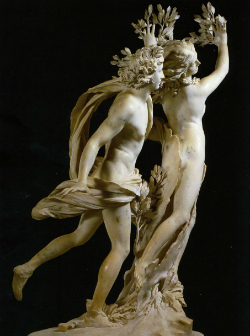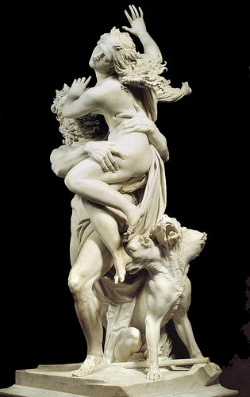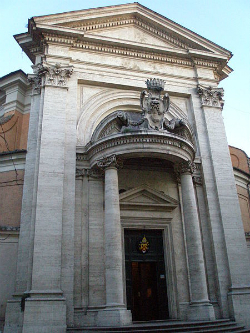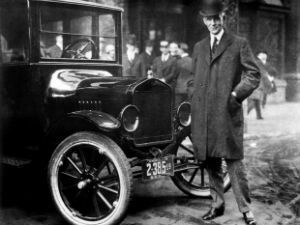Gian Lorenzo Bernini (1598-1680) was an Italian sculptor and architect considered the greatest expression of baroque. Much of his work is scattered in the cities of Rome and the Vatican.
Although he is best known for his work as an architect and sculptor, Bernini was a multiple artist. He also produced drawings, paintings and also produced shows.
Biography

Gian Lorenzo Bernini was born in Naples on December 7, 1598. As a child, Bernini moved with his family to Rome. Son of a sculptor, Pietro Bernini came into contact very early with the works of great Florentine artists.
He was educated knowing Roman, Greek and Renaissance sculpture and architecture. This condition helped him to develop a composition considered unusual for the time.
His works caught the attention of painter Annibale Carracci. The first pope who hired him was Paul V. The priest, considered one of the greatest enthusiasts of Bernini's work, was Cardinal Barberini.
The cardinal was elected Pope Urban VIII. Among Bernini's works commissioned by Pope Urban VIII is "San Sebastião" in 1617.
At the request of the Pope, he remodeled the church of Santa Bibiana in Rome during the years 1624 and 1926. He also designed and built the tomb of St. Peter, which is located in St. Peter's Basilica in the Vatican.
In the same basilica, Bernini assumed the decoration of the four pillars of the dome. The artist also designed and sculpted several busts, such as those of Cardinal Borgheses, in 1632.
Bernini sought to combine sculpture with architecture and, in order to be successful in the projects, he had the help of many assistants. His artistic precision caught the attention of the King of France, Louis XIV.
The king invited him to reform the Louvre, which did not happen because of differences of opinion about French and Italian art. Still, Bernini carved the bust of Louis XVI.
Bernini died in Rome on November 28, 1680 at the age of 81.
Characteristics of the Work
Following the Baroque movement, the main feature was to transport the viewer to the intensity of religious experience.
Thus, in Bernini's work we can observe:
- Overly expressive style
- shocking realism
- Details of facial expressions according to the character's emotion
- It is possible for the viewer to imagine that the work can speak, scream, rejoice and suffer
- Elongated bodies and expressive gestures
- In architecture: twisted columns, light games, among others
- Illusion of movement of bodies, hair and fabric
Main works
Sculpture
Apollo and Daphne

The life-size sculpture alludes to the Greek god Apollo's persecution of the nymph Daphne. The work demonstrates the exact moment when Daphne turns into a laurel tree as a way to protect herself from Apollo.
Among the details carved in marble is the illusion of movement of the scene for the viewer. Even the characters' hair eludes movement. This work is in the Galleria Borghese, in Rome, Italy.
The Abduction of Proserpine

This is considered one of Bernini's most fantastic works, carved when the artist was 24 years old.
In Greek mythology, Proserpina is Persephone, daughter of Demeter, who is kidnapped by Pluto and taken to the underworld. Remember that Pluto corresponds to Hades in Greek mythology.
Bernini elevates the sculpture to the height of realism, showing Pluto's fingers straddling Proserpina's skin. Fear is stamped on the face, as well as attempts to defend oneself from the perpetrator. This work can be found in the Galleria Borghese, in Rome, Italy.
The Ecstasy of Saint Teresa

This sculpture represents the moment when Santa Teresa de Ávila is reached by the angel of divine love.
The work is a combination of architecture, lighting and sculpture. It can be found in the Cornaro Chapel of the Church of Santa Maria della Vittoria in Rome, Italy.
Architecture
Bernini's architectural style also influenced urban planning. He created the 284 Ionic columns in St. Peter's Square in the Vatican and the interior of St. Peter's Basilica.

He designed and built the Fontana dei Quattro Fiumi (Fountain of the Four Rivers) between 1648 and 1651. This work was conceived at the request of Pope Innocent X. The work's name refers to the main rivers of the world's continents: River Nile, in Africa; Ganges River in Asia; Rio da Prata, in America; and the Danube River in Europe.

It was also he who designed the obelisk of the Piazza della Minerva (elephant obelisk) in 1667. Located in Rome, the sculpture gets its name because its base is an elephant.

One of the great works of Baroque architecture designed by Bernini was the church Sant'Andrea al Quirinale (Church of St. Andrew at the Quirinal), also located in Rome. The artist worked alongside Giovanni de'Rossi during 1658 and 1661.

Read too:
- Baroque style
- Baroque art
- Baroque Sculpture
- Baroque architecture
- Baroque painting



